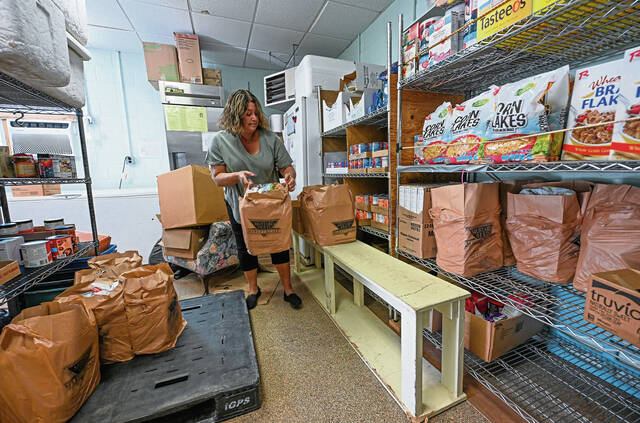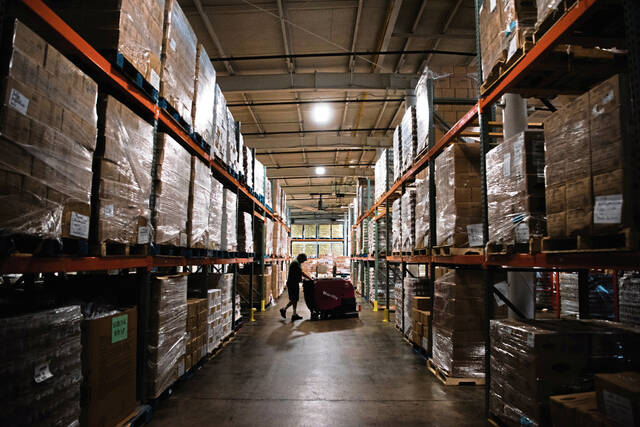Western Pa. food banks squeezed by increased costs, demand for assistance
Rising food costs are driving a renewed demand at food banks in the region that already were serving more people because of the covid pandemic.
“The cost of getting a gallon of milk is sometimes a hardship,” Westmoreland Food Bank CEO Jennifer Miller said.
After the pandemic hit, the Westmoreland Food Bank saw the number of families it served each month climb from 7,000 to about 9,500, Miller said.
The Greater Pittsburgh Community Food Bank, headquartered in Duquesne, reports its food recipient numbers are nearing peak pandemic levels.
It provided 1,341 families with emergency food assistance in June, compared with a record number of 1,604 it assisted in April 2020. Numbers also have increased for those who receive senior citizen boxes and those served through pantries or drive-up distributions.
Calls from those seeking help have exceeded 100 per day.
The Greater Pittsburgh staff is hearing from clients who are purchasing fewer fresh items and instead are buying cheaper, less-nutritious foods to stretch their budgets.
“We are seeing increases in need that are directly linked to the dramatic increase in basic living expenses being felt by all Americans,” said Charla Irwin-Buncher, the food bank’s chief development officer.
Westmoreland’s Miller said the same circumstances have been found there.
When prices at the grocery store started to rise this year, “a lot of people were calling to ask to be on the food bank rolls,” she said.
“We haven’t seen a huge increase in our (client) numbers, but we’re seeing people who never had to ask for help before,” she said.
There’s been an increased demand for staples, such as milk, bread, cereal and peanut butter at food banks, Miller said.
She recalled a conversation with a woman who experienced sticker shock when her grocery order totaled $250: “She looked at me and said, ‘This is going to last me a week.’ ”
Miller said the Westmoreland Food Bank is just starting to feel the pinch of rising prices because it purchases its food in advance. She indicated the cost of a truckload of food has jumped by as much as 40% since last year.
To help cover such rising expenses the food bank will look to a combination of grant funding and community donations, she said.
Allegheny Valley demand
Executive Director Karen Snair said the Allegheny Valley Association of Churches has seen demand for assistance at its food bank in Harrison’s Natrona Heights neighborhood increase by about 20% in recent months.
“When the gas prices started to spike, we were seeing more,” she said.
The organization offers two food distributions each month at the site and has seen more clients coming to each of the events instead of once a month.
It also conducts mass food distributions at Pittsburgh Mills in Frazer.
“Sometimes, the numbers dip there during the summer, but it definitely has not done that this summer,” Snair said.
The elevated cost of fuel has affected AVAC, which each month delivers food to about 100 families who lack transportation to Natrona Heights.
Snair said AVAC has been able to meet growing needs with financial support and donations from its 54 member churches and local service organizations and businesses.
“Whenever there is a need, this community steps up in an incredible way,” she said. She said many churches encourage their members to take advantage of buy one, get one free offers at supermarkets, with the free item donated to AVAC.
Related:
• Long lines are back at U.S. food banks as inflation hits high
• Grocery shoppers, restaurants face 'perfect storm' as prices surge
AVAC obtains much of its food through the Greater Pittsburgh bank.
“There has been some increase in the cost, but they’re doing their best to try and help us make it work,” Snair said.
Like the Westmoreland Food Bank, Greater Pittsburgh is part of a national Feeding America food bank network.
According to The Associated Press, Feeding America President Katie Fitzgerald has called on the U.S. Department of Agriculture and Congress to find a way to restore hundreds of millions of dollars worth of commodities recently lost with the end of several temporary programs to provide food to people in need. In 2021, USDA commodities accounted for more than 40% of food distributed through the Feeding America network.
With government commodities less available, Greater Pittsburgh must keep its warehouse stocked by purchasing more food at higher prices.
Food costs account for 70% of the organization’s budget, Irwin-Buncher said.
“Overall, our food cost is up 50%,” said food bank spokesman Brian Gulish. The price it pays for meat has increased from $1.11 per pound to $1.78.
He added that transportation costs are up by 20% as trips across an 11-county service area have increased for the food bank’s fleet of 10 trucks. Since last year, the number of partner organizations in the food bank’s network has jumped from 850 to 1,034.
“There are a lot of different funding channels we can tap into to try to offset some of the increase in costs,” Gulish said.
$2.5M budget jump
Citing the impact of inflation, Irwin-Buncher is anticipating a 10% increase — equal to $2.5 million — in the food bank’s cash budget next year.
“Our donor base of community members, foundations, corporations, and our partnership with Feeding America on the national level, have been responsive to helping ensure that the food bank has the resources needed to provide assistance to the community through direct service and through our partner programs,” she said.
North Hills Community Outreach has seen recipient visits to its three food pantries in Allison Park, Millvale and Avalon increase by close to 20%, according to coordinator Jon Jordan.
The organization also is piloting a mobile program to bring food to additional locations. A visit to Gibsonia is slated for Aug. 19.
Jordan said efforts through social media have helped NHCO solicit community donations of items needed for the pantries.
Other items are obtained from Greater Pittsburgh.
“Many of those items are free of cost,” Jordan said. “We just pay a small delivery fee.”
Fresh produce is grown in the organization’s garden.
“It’s a great way to get healthier options,” he said.
Jeff Himler is a TribLive reporter covering Greater Latrobe, Ligonier Valley, Mt. Pleasant Area and Derry Area school districts and their communities. He also reports on transportation issues. A journalist for more than three decades, he enjoys delving into local history. He can be reached at jhimler@triblive.com.
Remove the ads from your TribLIVE reading experience but still support the journalists who create the content with TribLIVE Ad-Free.



